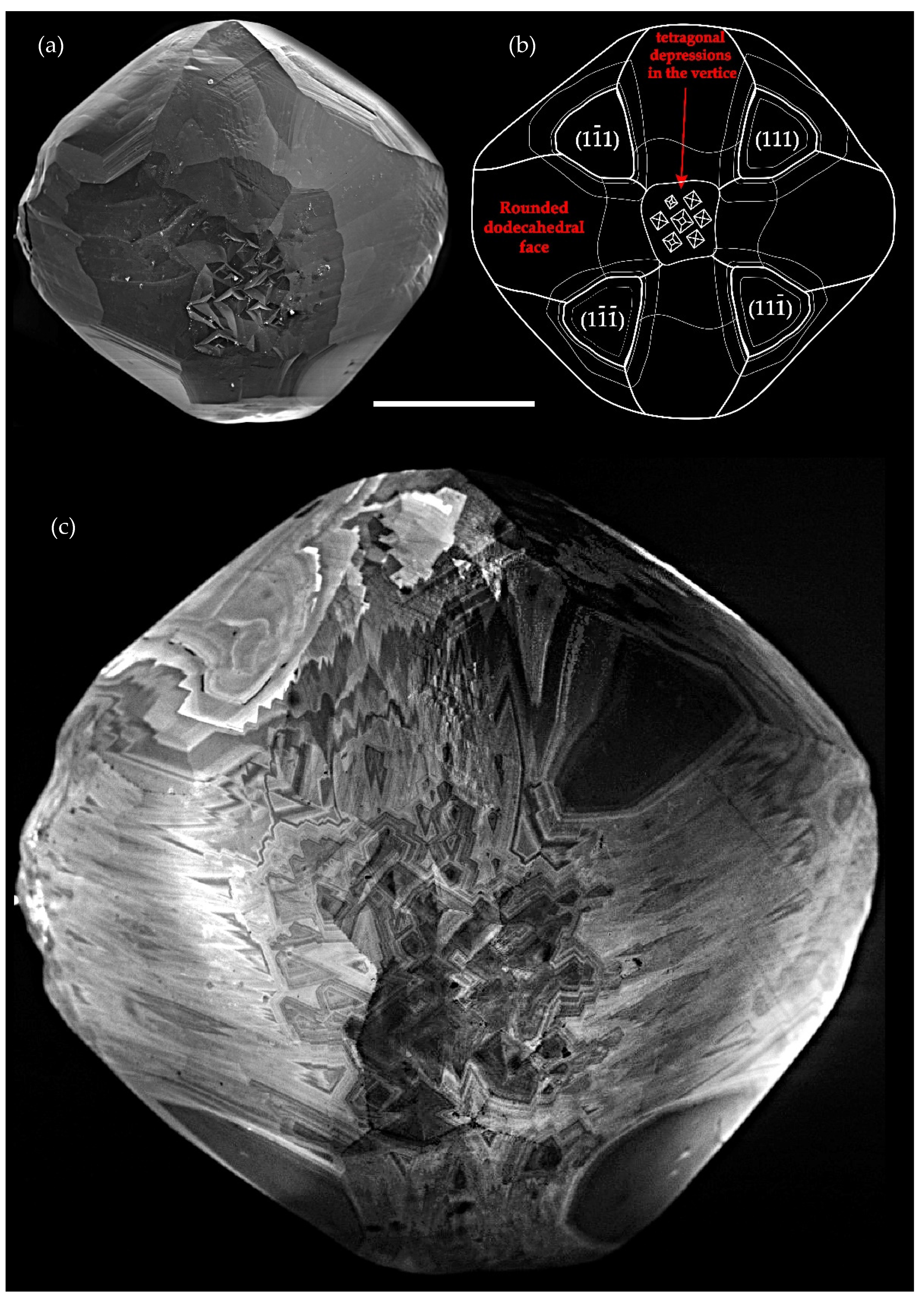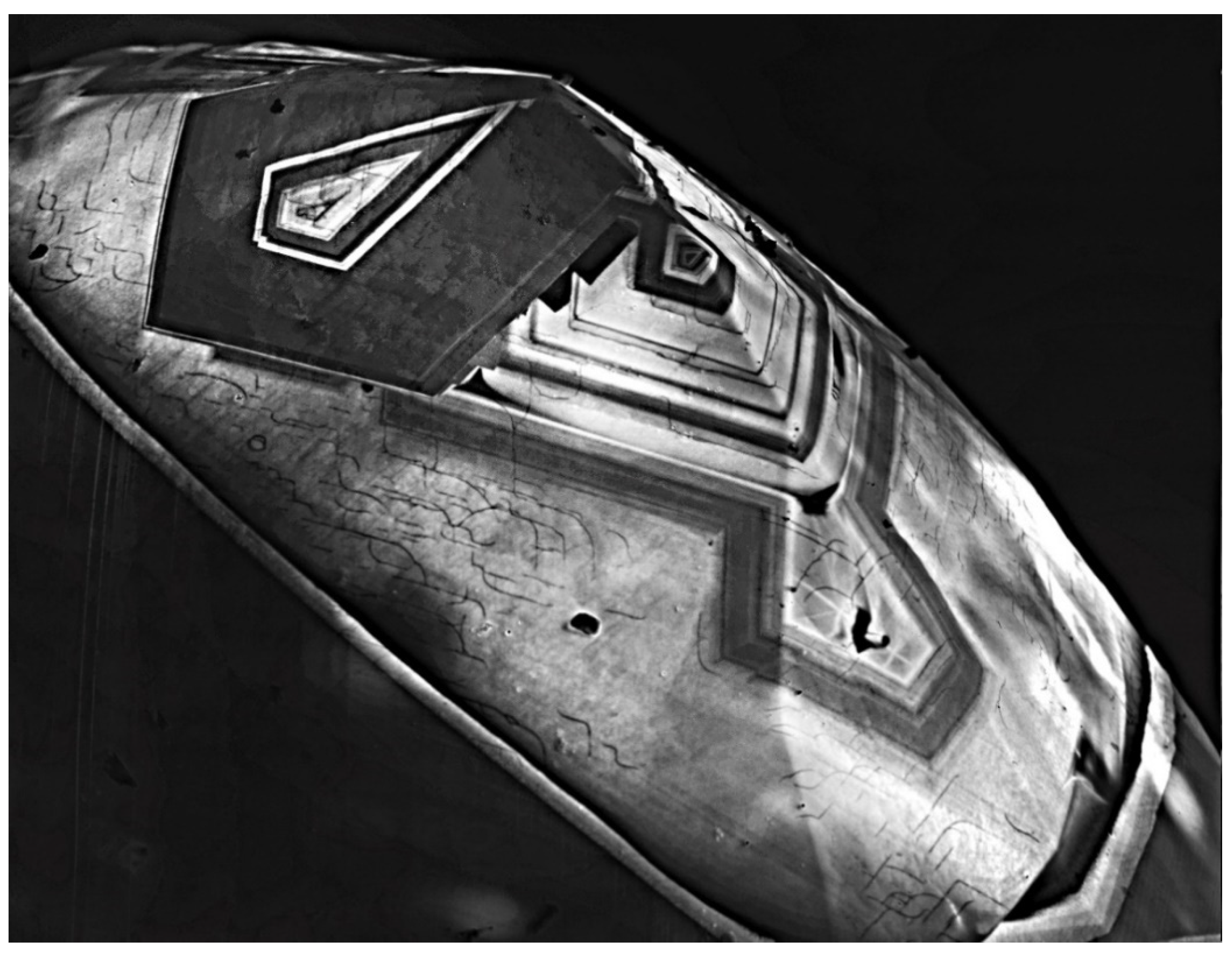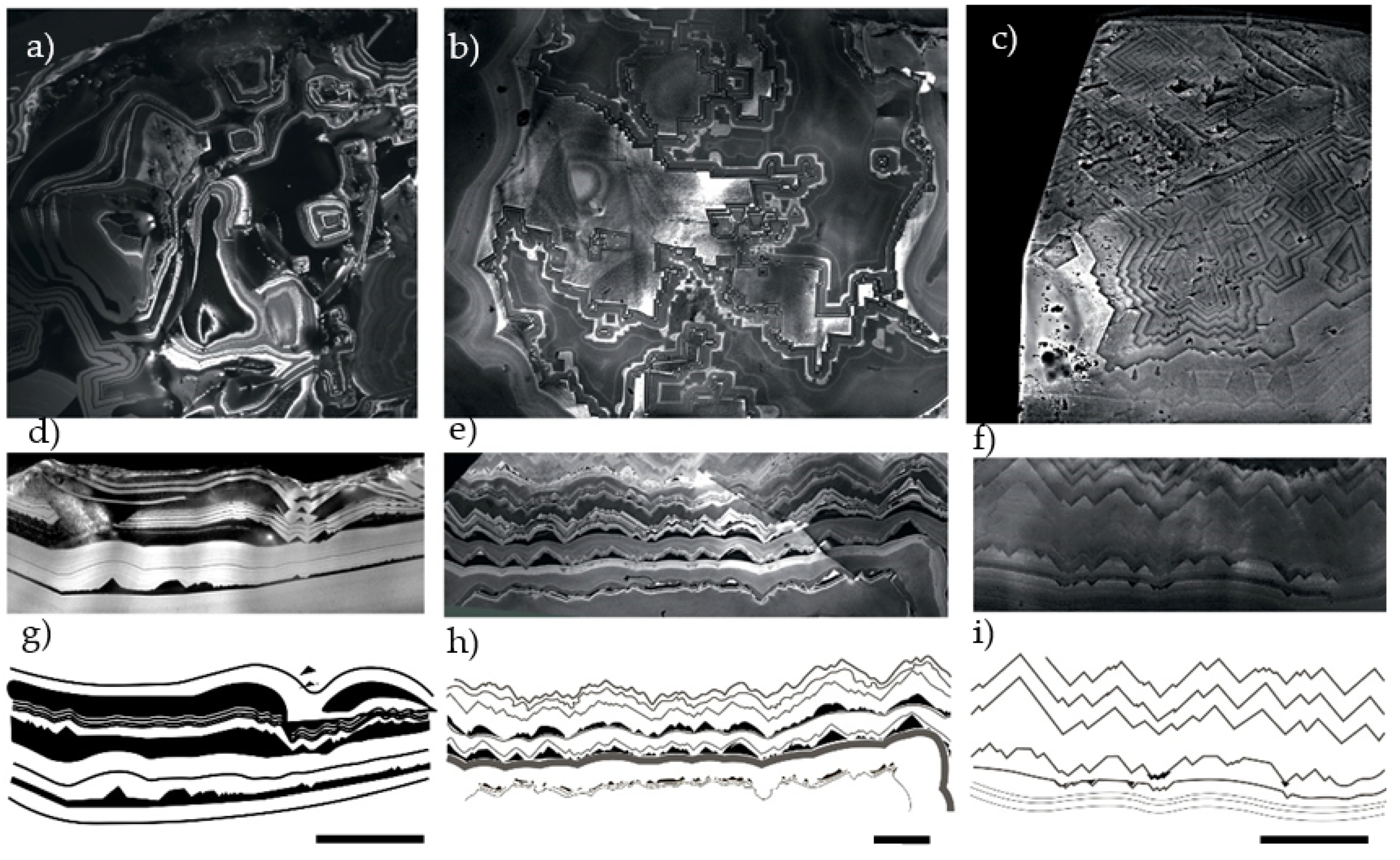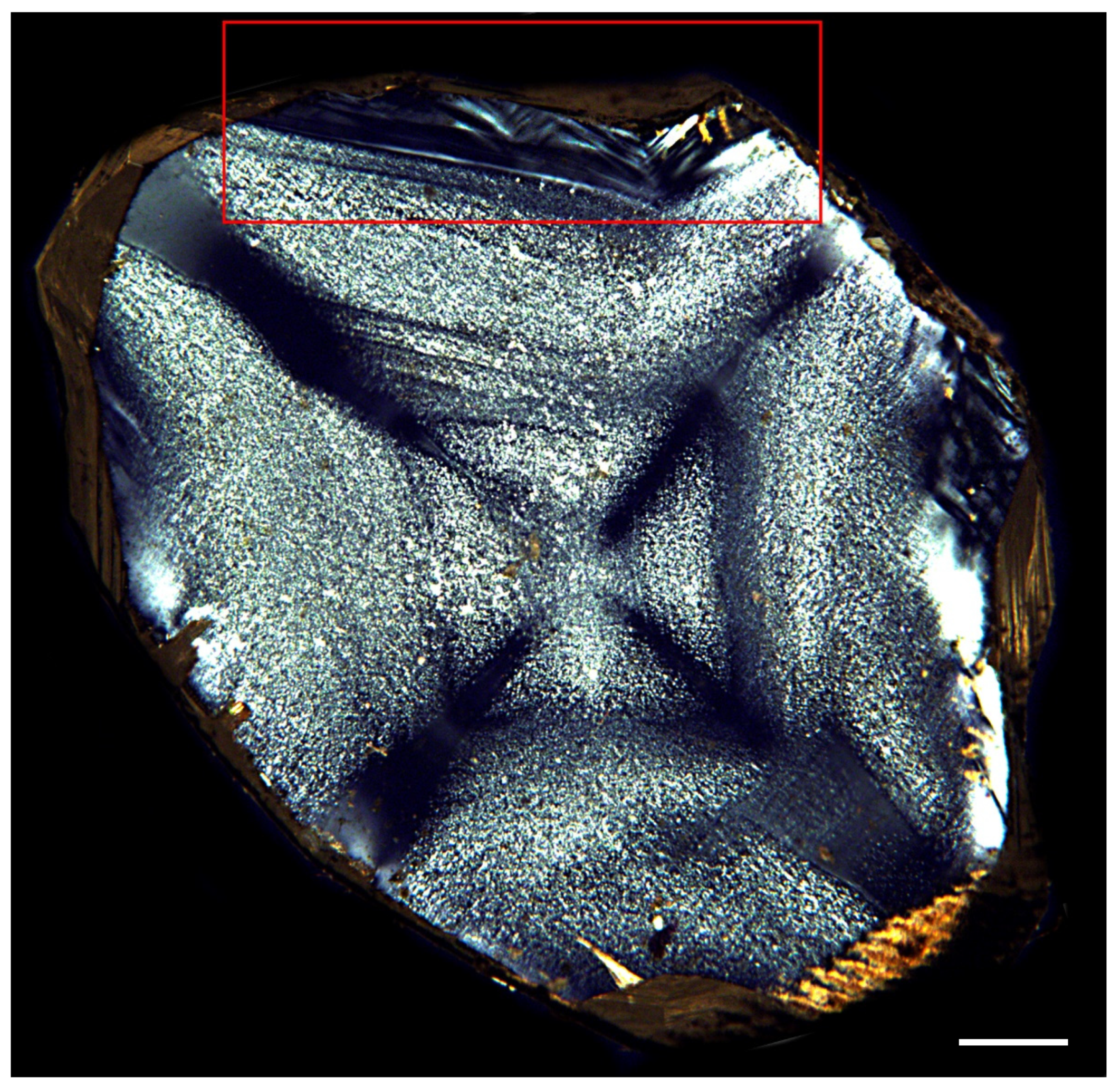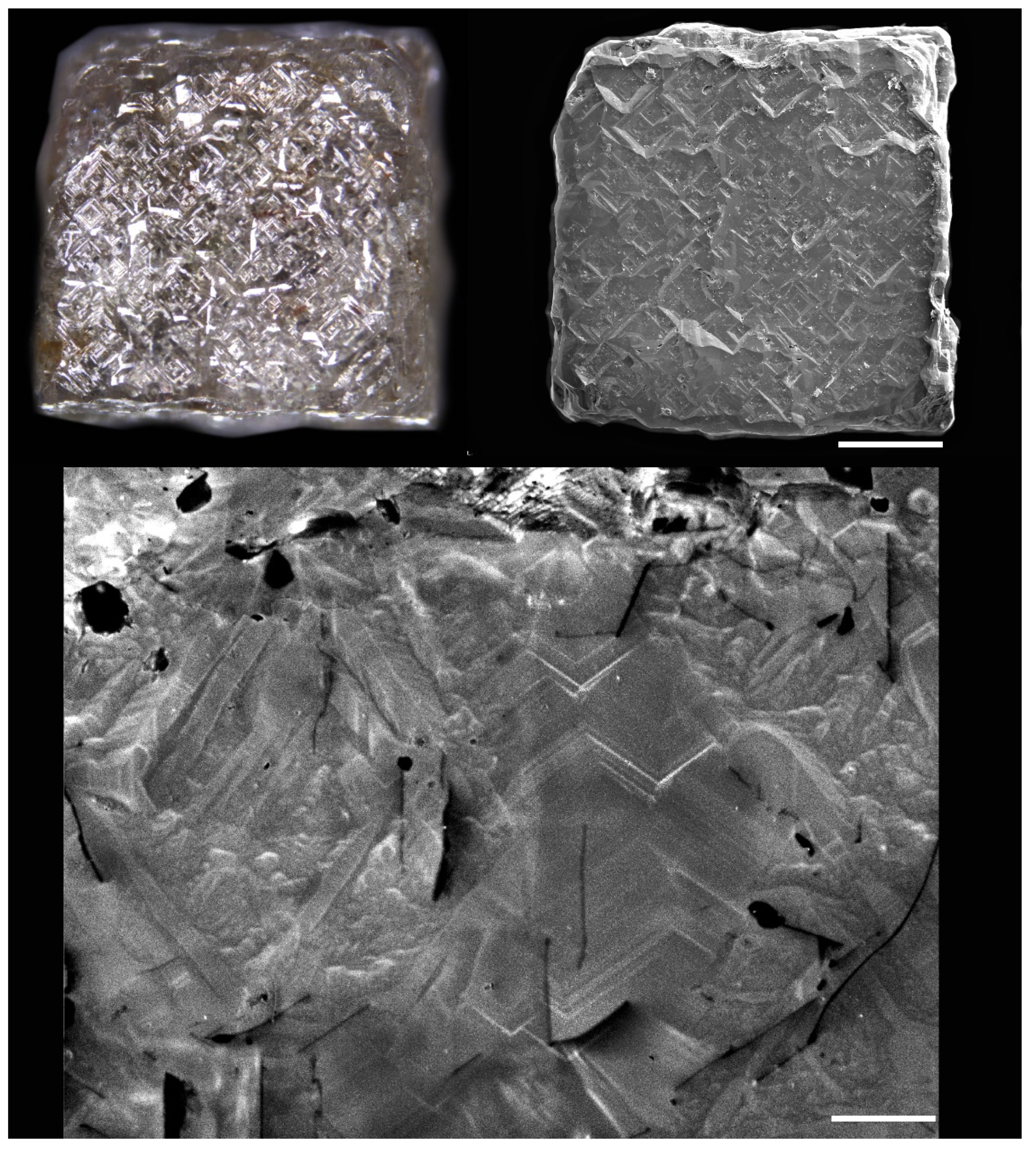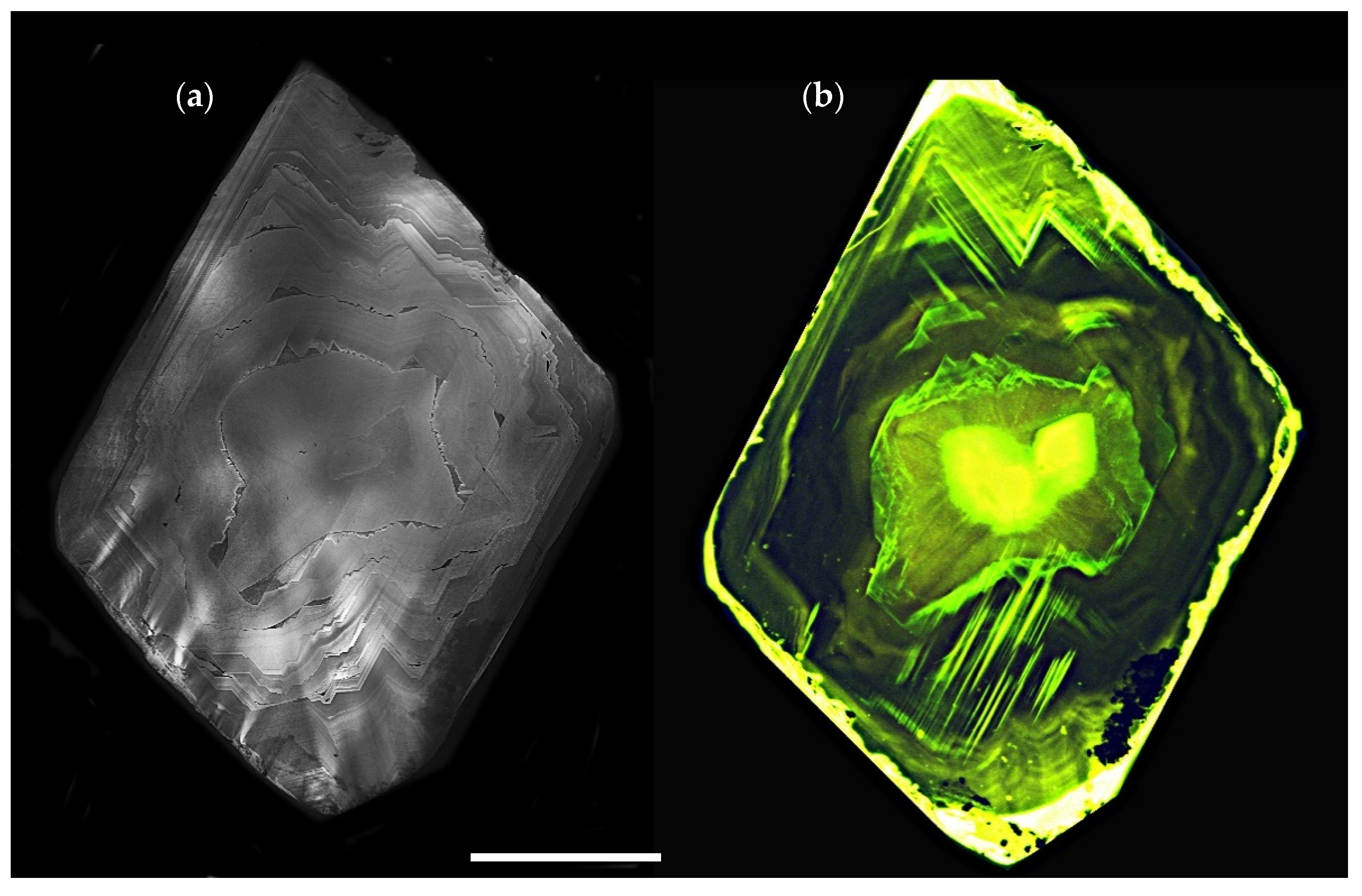1. Introduction
The morphological diversity of diamond crystals has been thoroughly described [
1,
2,
3,
4]. However, some issues of crystal growth remain controversial. An understanding of crystals’ internal structure helps to explain their morphology; many effects are associated with the polycrystalline structure of diamonds [
5]. Even in the case of single crystals, studying their internal structure is key to understanding many morphological characteristics [
6,
7,
8,
9]. The variety of diamond shapes in nature is a consequence of changes in their growth and dissolution conditions. V. Beskrovanov [
10] developed a schematic model of morphology evolution at the main stages of diamond formation. He provided a model of the dependence of the shape and internal structure of diamonds on supersaturation and time. This work is in good agreement with the concept [
11]. I. Sunagawa [
11] distinguished two growth mechanisms of diamond crystals in nature. The normal growth forms curved cuboid surfaces. The tangential growth forms flat octahedral facets. Further studies of diamonds [
9] revealed some types of internal structure and thermal history of crystals, which cannot be explained by these schematic models. Thus, the growth of cubic crystals corresponds to the early stages of crystallogenesis [
10,
11]. However, cubic crystals always have a very low degree of aggregation of nitrogen defects, which corresponds to low-temperature or short natural annealing. On the other hand, curved cuboid zoning is often observed in the core of octahedral crystals. This zoning is similar to low-temperature cuboids, but their spectroscopic characteristics correspond to diamonds with a long mantle residence time. Normal growth is realized at high supersaturation. It is characterized by multiple spots for atom attachment. In this case, there are many potential cavities, which can trap microinclusions. Nonsingular curved surfaces are formed because of this process. Tangential growth of singular faces implies the opposite situation. Low supersaturation and a flat surface make it difficult for atoms to attach. Ideal singular faces do not exist in natural crystals; small steps or vicinals appear on crystals as a result of emerging dislocations, and these steps help to attach atoms and thus dislocation-driven growth begins. In another case, growth begins with the adsorption of several neighboring atoms on a flat crystal surface, named two-dimensional nucleation [
12]. According to the dominant growth mechanism, in the bulk of octahedral crystals, zonal inhomogeneities have the shape of plane-parallel layers. In crystals composed of <100> growth sectors, zonal inhomogeneities have a wavy, in the limit-concentric shape. Therefore, according to the nature of cathodoluminescence zoning in crystals, the <100> and <111> growth sectors of faces are clearly separated and identified.
The change in growth mechanism occurs through tangential growth from the existing surface. In this case, the stage of nucleation of a new layer is absent. This variant is quite common in the internal structure of various minerals, including diamonds. In this case, small steps are formed on the dissolved surface, which then gradually move to singular faces. As a rule, the concept of “regeneration” is interpreted in the literature as the restoration of a destroyed or dissolved crystal.
In our research, the main meaning of the term “regeneration diamond growth” is an intermediate stage in the transition from normal to tangential growth [
13]. From the point of view of crystal morphology, this stage corresponds to the progression from cuboid to octahedron. In a supersaturated solution, at an early stage, diamonds grow by normal growth at a very high rate. After a short period (in a relative sense regarding the growth of crystals), nonsingular rough surfaces break up into small sites corresponding to singular faces [
14]. The surface of the crystal gains a stepped shape, and the sites propagate in the direction of normal growth. The transition from rough to stepped surfaces is due to the rapid filling of deep potential cavities and, accordingly, a drastic decrease in their amount. The steps formed in this way subsequently merge, enlarge and transform into singular faces of tangential growth. Crystal growth by tangential mechanism is much slower than by the normal one [
11]. The growth rate in this case is limited by the stage of two-dimensional nucleation or depends on the presence of screw dislocations.
The transition from the wavy zoning of <100> sectors to stepped regeneration growth in diamond crystals was documented over 40 years ago [
15]. Later, the internal structure of crystals with zones of habit transformation during regeneration growth was addressed in many studies [
16,
17,
18]. At the same time, the stage of regeneration growth of s diamond itself has never been investigated before. The existing publications usually address either cuboid zoning or directly flat faces formed by the tangential mechanism.
There is an interesting and long-standing debate about the nature of rounded dodecahedra, of whether it is a form of growth or dissolution [
2,
3,
19]. The paradox inheres in the fact that both sides are right: growth zoning, and thus, growth surfaces of a diamond are often truly curved. However, they determine the shape of individuals only in exceptional circumstances. The observed curved surfaces appear as a result of dissolutions [
20,
21,
22]. Dissolution and etching produce on diamond crystals tetragonal and triangular etch pits [
23]. Tetragonal depressions are quite interesting, because they can appear during both growth and etching. The tetragonal etch pits usually appear at the points of dislocation emergence at the surface [
24]. Experiments proved that the morphology of the walls of etch pits themselves significantly changes depending on the ratio of CO
2:CO and fugacity of O
2. When these ratios (as well as the temperature) change, the irregular cavities forming the bottom and the walls of tetrahedral etch pits evolve, through the development of the {100} microfaces, and conversion into {111} faces. The {111} face is the basic shape obtained in etching experiments with high CO
2 content. This indicates high diamond oxidation rates in the <111> direction [
25,
26]. Sonin et al. [
27] present the morphology of partially dissolved diamond in a Fe–S melt (sulfur content 15–30 wt.%) at 4.5 GPa and 1450 °C. The authors showed that the surface topography with an imbricate structure in the shape of stepped octahedral plates is formed upon dissolution of crystals. This should be considered in reconstructions of diamond growth history. It appears that experiments on diamond etching/dissolution usually describe in detail experimental conditions and morphology of the samples, but there are few descriptions of the internal structure, and there are no images of zoning. These data would help to understand better and explain the factors affecting certain shapes of etch figures, since not everything depends on external conditions.
Thus, regeneration and etching are the reverse processes that form the {111} faces and surface topography that is hard to distinguish in morphology. These processes may overlap and be repeated within the cycle of crystallogenesis. Today, the discussed concepts and experiments do not identify the regeneration growth of diamond crystals as a separate stage. However, it is actually very common in natural diamonds of any habit. Diamonds with surface topography driven by regeneration growth may be easily confused with etching patterns. However, these two stages of the diamond formation process are entirely different. The regeneration process is fixed by growth zoning and contains the history of crystal formation.
4. Discussion
The mechanism of normal growth is the fastest; it propagates the surface preferably in the <100> direction (growth rate in normal direction υ
100┴). This stage is the shortest, since it has the highest supersaturation and growth rate. Crystals can probably nucleate only at this stage [
10]. Diffusion limitation should prevail here. Normal growth is divided into “fibrous” and “cuboid” growth [
30]. In the studied cases, both options occur and then the regeneration behaves in the same way. Some large crystals grown under such conditions have been discovered. In some cases, such crystals formed independently, while in other cases, the small cores of octahedral diamonds were revealed.
The regeneration growth of the {111} faces is the tangential one with the rate υr111║. Regarding the range of supersaturation, regeneration growth occupies an intermediate position between the tangential and normal growth mechanisms. One of its key features is the absence of the facet nucleation stage (two-dimensional nucleation), in the case of tangential growth. Regeneration growth corresponds to the early stage of a flat-faced polyhedron formation, and stops after the formation of a convex polyhedron. Its rate in the <111> direction υr111║ is much lower than the rate of normal in the <100> direction (υr111║ << υ100┴).
However, with a decrease in supersaturation, the growth rates can be equal (υ
r111║ = υ
100┴); in this case, crystals of mixed habit or {111} lamellar-containing crystals grow. In such crystals with “mixed” growth, the regeneration of octahedral zoning begins to develop again or for the first time, with a further decrease in the growth rate. The growth rate of this zoning, as it was mentioned, is lower than normal growth rate, and it is much higher than the tangential one. When the tangential regeneration growth continues, the crystal gradually transforms into an octahedron; a schematic diagram of this process was demonstrated by Zedgenizov et al. [
18].
With a further decrease in supersaturation, the normal growth stops (υ100┴ = 0), but the change of crystal habit due to tangential growth takes place. This stage is longer than the first one, but the degree of nitrogen aggregation along the growth zones in such crystals does not change. Spectroscopic features of the regeneration stage diamond are the same as of conventional octahedrons.
When the habit transformation terminates, the growth rate is limited by two-dimensional nucleation or dislocation growth. This is the longest stage; the normal component of the growth rate (υ111┴) is several orders of magnitude less than υr111║. At this stage, the central cubic core of “cloudy” octahedral diamonds is annealed to the level of the rest of the octahedral crystal; there is enough time for the transformation of nitrogen defects A → B1. Based on the analysis of the internal structure of crystals and general models of the crystallization kinetics, it can be affirmed that υ100┴ >> υr111║ >> υ111┴. Growth rates of the above-mentioned components differ by orders of magnitude under the conditions corresponding to each mechanism.
At the new stage of diamond formation, due to the moving fluid-saturated kimberlite melt [
31] and an increase in carbon supersaturation, the coat on diamonds grew by the normal mechanism, along with regeneration filling of cavities of the growing surface. V. Beskrovanov identified this stage as a regression stage, but with regard to the dominant growth mechanism, it corresponds to the stages I–II of the next crystallogenesis cycle [
10]. Coated diamonds are rare; this fact can be explained by the local character of the fluid melt flow where the coat grows.
In general, the morphology and habit of the crystal can change significantly depending on the duration of the growth stages by normal and tangential mechanisms, as well as the dissolution and subsequent regeneration stages. When crystals with polycentric growth dissolve, their surface can become more complex, since etch pits are overlaid on the growth relief. Thus, the complex morphology of diamonds is often associated with the change of crystal habit during regeneration growth. The high rate of regeneration growth allows all crystals of a cubic or mixed habit (crystals of initial steps of crystallogenesis) to pass through the stage of habit transformation.
Figure 9 summarizes the results and presents the final schematic diagram (upgraded and updated from [
10]) of the diamond formation process. The diagram is based on the main mechanisms of diamond growth and takes into account the most important regeneration stage. It is remarkable that all the stages of this diagram are completely reversible and interchangeable. One crystal can be pure cuboid all the way to the rim. Another crystal can reach a flat-faced octahedral morphology, having moved all the way from the fibrous core, or it can grow by a tangential mechanism almost immediately. Additionally, after going through all these options, the crystal can return to the beginning or achieve any of the stages for the first time. Additionally, it can grow with a constant alternation of only two stages, for example. That is, in the process of diamond crystal growth, there are hardly any separate reservoirs for the growth of only cuboids or only flat-faced crystals. Additionally, it is also unlikely that in most cases, there is depth zoning for the formation of a particular crystal type in the mantle.
A number of works [
32,
33,
34,
35] described octahedral crystals with a central core consisting of a “fibrous” cuboid. The general feature of such crystals is that, after the formation of fibrous cube, the stage of regeneration with {111} apices begins and continues almost until the end of crystal growth. Such crystals are not rare. Rondeau et al. [
33] proposed three models of formation of such crystals: (1) the fibrous diamond grows fast in a medium with a high driving force, then the crystal is moved and the fibrous cuboid serves as a seed for the growth of an octahedron; (2) fibrous growth during the first stage of the rise of kimberlite, which stopped in the upper mantle (in the diamond stability field), then the crystal stays under these conditions and grows by tangential mechanism, and then it is moved to the surface; (3) the crystal grows in a reservoir with a high driving force, which gradually decreases, and at the critical point, transitions to tangential growth-ascending kimberlite melt before eruption onto the surface. A crystal that passes through all the stages from the schematic diagram (
Figure 9) is shown in
Figure 8. It hardly fits these three interesting hypotheses. The third option seems to be the most possible. The stages from diagram may alternate in different sequences. If the fluctuations of the growth conditions are so weak that the growth mechanism can change almost for each new layer, then there is no significant difference in the dependence of the crystal growth pathway on its internal structure.
Most likely, the vast majority of diamond crystals stay in the close conditions and depths. The difference is that during their crystallization from the melt, there is irregular supply of material, irregular composition, location and orientation of the seed in the volume of the medium. There is also uneven supersaturation in the volume of the growth medium, uneven temperature and pressure distribution in different parts of crystallization volume, and irregular chemical composition of the medium. Therefore, crystals with completely different morphology and properties can grow within one hypothetic chamber or vein. However, their further way to the surface may differ significantly (growth rate, time, temperatures, etc.). In this case, the formation of annealing-driven and many other types of defect-impurity centers occur. It seems that initially there were not so many of them. Then, the “natural treatment” occurred. Another argument to support this position is the advancements in synthetic diamond manufacturing technology. It is possible to reproduce the morphology of crystals, to produce more than half of defect-impurity centers in diamond crystals, to anneal and improve the quality of crystals in laboratories. These achievements are possible due to the ability to vary the growth process parameters, temperature, pressure and growth medium composition inside a growth cell up to 8 cm in diameter.
Regeneration growth and formation of growth-related tetragonal depressions is confirmed by experiments on growing synthetic diamond crystals by a high-temperature high-pressure gradient method in the Fe
3N–C system [
36], S–C system [
37], and Fe
5Ni
4S
8–C system [
38]. In the Fe
3N–C system at a pressure of 7 GPa, a temperature of 1650 °C and synthesis time of 20 h, the regeneration growth of {111} faces on cubo-octahedral seed crystals was observed with the habit change into an octahedron, and its vertices were formed by growth-related tetragonal depressions. In the S–C system at pressures 6.3–7.5 GPa, temperatures 1700–2000 °C and synthesis time of 9–40 h, the regeneration growth of {111} faces in the <100> direction, forming tetragonal depressions, was also observed on diamond crystals. During the interaction of pentlandite melt and carbon at the P–T parameters of 7 GPa and 1550–1800 °C, {111} regeneration surfaces developed on the {100} faces of diamond seed crystals. Therefore, diamond regeneration processes are common in Fe–S melts at the parameters close to 7 GPa and 1700 °C. Moreover, a complete regeneration of crystals does not take long (from 10 to 40 h), which once again confirms a high growth rate.
Diamond synthesis by the chemical vapor deposition (CVD) technique also reveals the formation of regeneration layers and tetragonal depressions. This occurs under certain conditions when the synthesis temperature is increased [
39]. Tallaire et al. grew CVD layers in the <100> direction. At temperatures above 900 °C, a typical stepped structure of the crystal surface (with tetragonal depressions) was observed (T = 920 °C, growth rate 7 μm/h). Under the same conditions and at rather low temperature, the surface remained smooth (870 °C, 6 μm/h). It should be noted that, in general, the process of CVD growth of diamond crystals on a substrate is similar to the described phenomenon of regeneration growth. For the preparation of the substrate, its surface is deviated from the singular face and then etched to form an atomic scale stepped surface [
40]. Under these conditions, carbon atoms will settle on the steps and the growth of a singular crystal face by layer-by-layer tangential mechanism takes place.
Synthetic diamond crystals grow by tangential mechanism; however, the morphology of the crystals may reveal various simple forms. It takes from 10 to 12 days to grow large (up to 20 ct) nitrogen-free and dislocation-free synthetic crystals. Synthetic diamonds rarely grow via the normal mechanism [
41,
42], because the parameters and medium are specially selected to provide fast and high-quality growth.
Therefore, based on growth experiments and theoretical background, it is fair to say that the formation of natural cuboids and mixed-habit crystals was very fast. In some cases, only minor part of crystals reached the stage of flat faces growth. The formation of flat-faceted octahedrons was the only relatively long stage of diamond growth. Subsequently, there were some differences in the conditions of mantle residence of the crystals: cuboids were not exposed to prolonged annealing, while mixed-habit and octahedral crystals (flat-faced and regenerated ones) could be exposed to prolonged annealing in the mantle. Moreover, there is a number of deposits with only flat-faced crystals without signs of normal growth in the internal structure. It apparently had specific conditions with initial slower growth rate.

